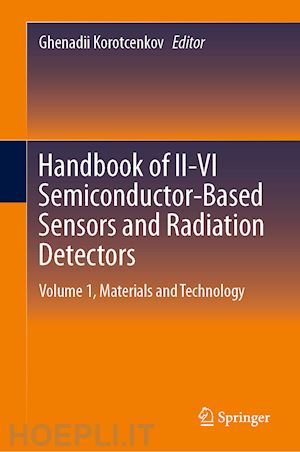
Questo prodotto usufruisce delle SPEDIZIONI GRATIS
selezionando l'opzione Corriere Veloce in fase di ordine.
Pagabile anche con Carta della cultura giovani e del merito, 18App Bonus Cultura e Carta del Docente
Three-volumes book “Handbook of II-VI Semiconductor-Based Sensors and Radiation Detectors” is the first to cover both chemical sensors and biosensors and all types of photodetectors and radiation detectors based on II-VI semiconductors. It contains a comprehensive and detailed analysis of all aspects of the application of II-VI semiconductors in these devices. The first volume "Materials and Technologies" of a three-volume set describes the physical, chemical and electronic properties of II-VI compounds, which give rise to an increased interest in these semiconductors. Technologies that are used in the development of various devices based on II-VI connections, such as material synthesis, deposition, characterization, processing, and device fabrication, are also discussed in detail in this volume. It covers also topics related to synthesis and application of II-VI-based nanoparticles and quantum dots, as well their toxicity, biocompatibility and biofunctionalization.
Introduction in II-VI semiconductors.- (general view, history).- Cd-based II-VI semiconductors.- (CdSe, CdS, CdTe, structure, optical properties, luminescence, electrical conduction, photoconductivity).- Zn-based II-VI semiconductors.- (ZnSe, ZndS, ZnTe, structure, optical properties, luminescence, electrical conduction, photoconductivity).- Hg-based II-VI semiconductors.- (HgTe; HgS; HgSe, structure, elecrophysical propertie).- Ternary II-VI compounds.- (CdZnTe, HgCdTe, HgZnTe).- Bandgap engineering.- Synthesis of II-VI semiconductors.- (single crystals, polycrystals, wet chemical synthesis, features, crystallite sizes, sintering),.- Thin films of II-VI semiconductors.- (features, deposition, characterization).- Epitaxial growth of II-VI semiconductors .- (approaches, deposition, characterization).- Doping of II-VI semiconductors.- (approaches, limitations, p-n junction forming, characterization).- Schottky barriers and ohmic contacts to II-VI semiconductors.- (formation, approaches, parameters, limitations).- Patterning of II-VI semiconductor films.- (etching: wet, dry).- Stability of II-VI semiconductors.- (thermal, temporal, stabilization, surface passivation).- Colloidal II-VI semiconductor-based nanoparticles.- (quantum dots, synthesis, stabilization).- 1D II-VI semiconductor-based nanomaterials .- (nanowires, nanobelts, etc. synthesis, characterization).- 2D II-VI semiconductor-based nanomaterials .- (nanoflakes, nanosheets, etc., synthesis, characterization).- 3D II-VI semiconductor-based nanomaterials .- (core-shells, spherical, hierarchical structures, etc., synthesis, characterization).- .- Introduction in IR detectors.- (Classification, Infrared Detector Market, materials, HgCdTe, limitations, applications).- Photoconductive and photovoltaic IR detectors .- (HgCdTe, HgZnTe, high operation temperature (HOT) IR detectors, sensor design, p-n junction, barrier photodetectors, characterization, performances, application, advantage, disadvantages).- Avalanche photodiodes for IR spectral region .- (HgCdTe, p-i-n, principles of operation, fabrication, performances, application, advantage, disadvantages).- Photoelectromagnetic (PEM) detectors, magnetoconcentration detectors, and Dember effect IR detectors.- (design, characterization, performances, application, advantage, disadvantages).- Quantum Cascade and Quantum well IR Detectors.- (HgCdTe, design, fabrication, characterization, performance, application, advantage, disadvantages).- IR detectors array.- (photoconductive array, photodiode array, design, array technology, fabrication, performance, application).- Nanomaterial-based IR detectors.- (HgTe, HgSe, QDs-based IR detectors, nanocrystals, colloidal, 1D and 2D structures).- CdSe-based photodetectors for visible-NIR spectral region.- (all types of detectors, including nanomaterials (thin films, 1D, 2D, 3D, QDs, colloidal, nanocrystals), design, fabrication, performance, application).- CdTe-based photodetectors for visible-NIR spectral region.- (all types of detectors, including nanomaterials (thin films, 1D, 2D, 3D, QDs, colloidal, nanocrystals), design, fabrication, performance, application).- CdS-based photodetectors for visible-UV spectral region.- (all types of detectors, including nanomaterials (thin films, 1D, 2D, 3D, QDs, colloidal, nanocrystals), design, fabrication, performance, application).- Photodetectors for visible spectral range based on ternary and.- multinary alloys of II-VI semiconductors.- (ZnSTe, CdZnTe, ZnSeTe, etc., design, fabrication, performance, application).- Introduction in UV detectors.- (Principles of operation, materials used, classification, applications).- Schottky barrier-based and heterojunction-based UV detectors.- (ZnS, ZnSe, design, fabrication, characterization, performance, application, advantage, disadvantages).- Avalanche UV photodiodes.- (ZnS, ZnSe, p-i-n, design, fabrication, characterization, performance, application, advantage, disadvantages).- Nanomaterial-based UV photodetectors.- (ZnS, ZnSe, 1D, 2D, 3D, QDs, design, fabrication, characterization, performance, advantage, disadvantages).











Il sito utilizza cookie ed altri strumenti di tracciamento che raccolgono informazioni dal dispositivo dell’utente. Oltre ai cookie tecnici ed analitici aggregati, strettamente necessari per il funzionamento di questo sito web, previo consenso dell’utente possono essere installati cookie di profilazione e marketing e cookie dei social media. Cliccando su “Accetto tutti i cookie” saranno attivate tutte le categorie di cookie. Per accettare solo deterninate categorie di cookie, cliccare invece su “Impostazioni cookie”. Chiudendo il banner o continuando a navigare saranno installati solo cookie tecnici. Per maggiori dettagli, consultare la Cookie Policy.